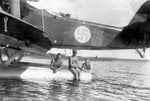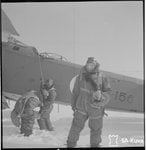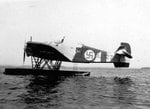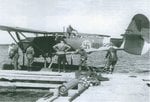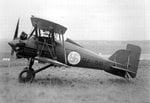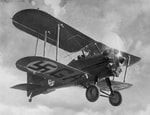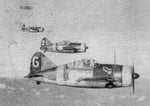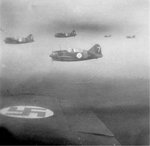The Finnish Air Force was founded on 6th March 1918. There was one exceptional feature in the founding of the FAF, that it was organized right from the start as an independent branch of the armed forces. This foresight created a good basis for its development and made it one of the oldest air forces in the world. The first aircraft was donated by a Swedish count, Erik von Rosen. On the wings of the airplane was painted his personal lucky insignia, the blue swastikas. This was the origin of the first official Finnish Air Force markings. The swastikas, still seen in many FAF traditional markings, as insignias have nothing to do with the Nazi swastikas of the 1930s.
The Winter War was the first real baptism of fire for the Finnish Air Force. The Soviet Union and Nazi Germany formed a pact in 1939 which resulted in the German attack on Poland in September of that year. Subsequent to that assault was the Soviet Union's attack on Finland on November of the same year. The Defence Forces of Finland was ill-prepared for the war from a material standpoint. In the Air Force for example the number of fighters was alarmingly small. However, their training and therefore their combat readiness was fairly high. Actually, The Finnish Air Force was the inventor of the modern fighter tactics.
Before and in the beginning of the second World War the ideas of general Douhet were noticed in many air forces and accordingly the fighter forces were rather universally underestimated. Fighter tactics also was hampered by peace time formalities. In Great Britain the two types of fighter formation were either built up from a tight vic of three aircraft or four in line-astern. The vic was a legacy of peace time flying in which the two wingmen had all their work cut out to stay near their leader and little time to search the sky. The high casualty rate of the tail-end Charlies was a grim measure of the vulnerability of the line-astern formations. During the Battle of Britain the RAF renewed both its formation tactics and training.
In Germany the Luftwaffe was founded again in 1933 and the Chief of the Luftwaffe General Staff, general Wever, emphasized strategic bombers as the main aircraft of the new organization. After Wever had died in the flight accident in 1936 the new technical chief, Ernst Udet, brought from a trip to USA the idea of dive bombers as the most suitable method for the blitzkrieg philosophy. The German bi-plane fighters, Arado Ar 65/68 and Heinkel He 51, used in the Spanish Civil War, proved to be inferior compared to the adversaries I-15 and I-16 from Soviet Union. However, in 1938 both the fighters and the fighter tactics in Luftwaffe were renewed when Legion Condor got the new Bf 109 B-2 fighters in use.
In the Soviet Union the bombers had the priority in the operational planning of the air forces during the 1930s. Also the Soviet Union participated the Spanish Civil War but its Air Force elements were used as the subordinated support units to the Army and thus for example the fighter tactical lessons were unlearned. The Soviets kept on using the tight three fighters formation as the basic tactical element in air combat and the wingmen were to fire anytime the leader did so. The weapons were lined straight ahead.
Some of the first American fighter combat experiences came via Flying Tigers in China. They started by using eight fighters tight formation but cancelled it soon and changed both tactics and training. Also Japanese first used rather big formations, for example fifteen Mitsubishi 96 Claude fighters in tight Vic-formation in their Chinese campaign. In Finland the Air Force started during the years 1934 and 1935 to use the loose and broad section as the basic formation in fighter aviation. The bigger formations were built so that two sections flying side by side made a finger four division. In a flight formation two divisions flew almost side by side while the top division was much higher than the lower strike division. In divisions, the sections still operated independently. These formations, at that time differing from all international principles, were developed during fighter courses in both theoretical analyses and practical exercises. The Finnish fighter pilots concluded that they would never have such big numbers of fighters that they could build up those great squadron formations which were used abroad to concentrate fighter power to certain areas. They also concluded that big and tight fighter formations were tactically inefficient.
The most important element in the fighter combat was surprise, and that was the goal which always had to be tried to reach for. A big and tight formation could very seldom achieve the surprise because it was easily seen from far away and the pilots couldn't keep good lookout while working to maintain their positions in the formation. On the other hand a section with the two fighters about 100 - 150 yards away from each other, or the division with 300 - 400 yards between the two sections, were found very effective in the search exercises. Every pilot was free to keep a good lookout to every direction and also all the time to check the six of the other pilots. In addition to that this kind of small and loose formation was seen much later because all of its aircraft were not always at the same time in the view of the opponent. The search phase was heavily emphasized in the training and the ability in that was an important factor in the evaluation of the fighter pilots.
When the aerial engagement began every pilot was free to manoeuvre in the most effective way, so, both the attacks and the evasive manoeuvres could be done without any delays. The flying in the small formations meant continuous fighting against bigger numbers but this could be compensated by always attacking regardless of numbers. The fighter combat generally spread quite quickly into section fights and duels where there was no immediate benefit of the bigger numbers. In these separate combats the better pilots always won. However, this philosophy demanded that every pilot was a skilful air combatant. This skill was trained for both in the fighter courses and in the squadrons.
One of the corner stones in the skill of the fighter pilot was the complete control of his aircraft. This was trained by aerobatics and combat manoeuvres, and also by intentional mis-manoeuvring. In the classic one versus one and two versus two exercises and in the practice attacks on bomber targets the combat manoeuvres were trained as instinctive actions. In practical exercises the simple manoeuvres were found to be the best ones. It was also found in training that one of the most important skills of fighter pilot was the shooting accuracy; the ability to judge the right deflection during manoeuvring, to estimate the right shooting distance and to concentrate the fire on the point target, for example on some vulnerable part of the target airplane. The shooting training became an essential, and in times dominating, part of the fighter training.
When the Winter War started the Finnish fighter tactics differed from almost all other countries` tactical principles. Only the Germans had started to use similar methods during the Spanish Civil War. There was no certainty of how this tactics would do in the merciless test of war. The numbers of the attacking Soviet Union seemed to be crushingly overwhelming. However, there was no hesitation about the defence task in the flying units. At least in that sense the training had succeeded; it had created a fighter pilot cadre with high motivation and self-confidence.
The Winter War was the first real baptism of fire for the Finnish Air Force. The Soviet Union and Nazi Germany formed a pact in 1939 which resulted in the German attack on Poland in September of that year. Subsequent to that assault was the Soviet Union's attack on Finland on November of the same year. The Defence Forces of Finland was ill-prepared for the war from a material standpoint. In the Air Force for example the number of fighters was alarmingly small. However, their training and therefore their combat readiness was fairly high. Actually, The Finnish Air Force was the inventor of the modern fighter tactics.
Before and in the beginning of the second World War the ideas of general Douhet were noticed in many air forces and accordingly the fighter forces were rather universally underestimated. Fighter tactics also was hampered by peace time formalities. In Great Britain the two types of fighter formation were either built up from a tight vic of three aircraft or four in line-astern. The vic was a legacy of peace time flying in which the two wingmen had all their work cut out to stay near their leader and little time to search the sky. The high casualty rate of the tail-end Charlies was a grim measure of the vulnerability of the line-astern formations. During the Battle of Britain the RAF renewed both its formation tactics and training.
In Germany the Luftwaffe was founded again in 1933 and the Chief of the Luftwaffe General Staff, general Wever, emphasized strategic bombers as the main aircraft of the new organization. After Wever had died in the flight accident in 1936 the new technical chief, Ernst Udet, brought from a trip to USA the idea of dive bombers as the most suitable method for the blitzkrieg philosophy. The German bi-plane fighters, Arado Ar 65/68 and Heinkel He 51, used in the Spanish Civil War, proved to be inferior compared to the adversaries I-15 and I-16 from Soviet Union. However, in 1938 both the fighters and the fighter tactics in Luftwaffe were renewed when Legion Condor got the new Bf 109 B-2 fighters in use.
In the Soviet Union the bombers had the priority in the operational planning of the air forces during the 1930s. Also the Soviet Union participated the Spanish Civil War but its Air Force elements were used as the subordinated support units to the Army and thus for example the fighter tactical lessons were unlearned. The Soviets kept on using the tight three fighters formation as the basic tactical element in air combat and the wingmen were to fire anytime the leader did so. The weapons were lined straight ahead.
Some of the first American fighter combat experiences came via Flying Tigers in China. They started by using eight fighters tight formation but cancelled it soon and changed both tactics and training. Also Japanese first used rather big formations, for example fifteen Mitsubishi 96 Claude fighters in tight Vic-formation in their Chinese campaign. In Finland the Air Force started during the years 1934 and 1935 to use the loose and broad section as the basic formation in fighter aviation. The bigger formations were built so that two sections flying side by side made a finger four division. In a flight formation two divisions flew almost side by side while the top division was much higher than the lower strike division. In divisions, the sections still operated independently. These formations, at that time differing from all international principles, were developed during fighter courses in both theoretical analyses and practical exercises. The Finnish fighter pilots concluded that they would never have such big numbers of fighters that they could build up those great squadron formations which were used abroad to concentrate fighter power to certain areas. They also concluded that big and tight fighter formations were tactically inefficient.
The most important element in the fighter combat was surprise, and that was the goal which always had to be tried to reach for. A big and tight formation could very seldom achieve the surprise because it was easily seen from far away and the pilots couldn't keep good lookout while working to maintain their positions in the formation. On the other hand a section with the two fighters about 100 - 150 yards away from each other, or the division with 300 - 400 yards between the two sections, were found very effective in the search exercises. Every pilot was free to keep a good lookout to every direction and also all the time to check the six of the other pilots. In addition to that this kind of small and loose formation was seen much later because all of its aircraft were not always at the same time in the view of the opponent. The search phase was heavily emphasized in the training and the ability in that was an important factor in the evaluation of the fighter pilots.
When the aerial engagement began every pilot was free to manoeuvre in the most effective way, so, both the attacks and the evasive manoeuvres could be done without any delays. The flying in the small formations meant continuous fighting against bigger numbers but this could be compensated by always attacking regardless of numbers. The fighter combat generally spread quite quickly into section fights and duels where there was no immediate benefit of the bigger numbers. In these separate combats the better pilots always won. However, this philosophy demanded that every pilot was a skilful air combatant. This skill was trained for both in the fighter courses and in the squadrons.
One of the corner stones in the skill of the fighter pilot was the complete control of his aircraft. This was trained by aerobatics and combat manoeuvres, and also by intentional mis-manoeuvring. In the classic one versus one and two versus two exercises and in the practice attacks on bomber targets the combat manoeuvres were trained as instinctive actions. In practical exercises the simple manoeuvres were found to be the best ones. It was also found in training that one of the most important skills of fighter pilot was the shooting accuracy; the ability to judge the right deflection during manoeuvring, to estimate the right shooting distance and to concentrate the fire on the point target, for example on some vulnerable part of the target airplane. The shooting training became an essential, and in times dominating, part of the fighter training.
When the Winter War started the Finnish fighter tactics differed from almost all other countries` tactical principles. Only the Germans had started to use similar methods during the Spanish Civil War. There was no certainty of how this tactics would do in the merciless test of war. The numbers of the attacking Soviet Union seemed to be crushingly overwhelming. However, there was no hesitation about the defence task in the flying units. At least in that sense the training had succeeded; it had created a fighter pilot cadre with high motivation and self-confidence.







